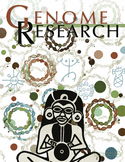Genome-scale analysis of aberrant DNA methylation in colorectal cancer
- Toshinori Hinoue1,
- Daniel J. Weisenberger1,
- Christopher P.E. Lange2,3,
- Hui Shen1,
- Hyang-Min Byun4,
- David Van Den Berg1,
- Simeen Malik1,
- Fei Pan1,
- Houtan Noushmehr1,
- Cornelis M. van Dijk5,
- Rob A.E.M. Tollenaar3 and
- Peter W. Laird1,6
- 1Department of Surgery and Department of Biochemistry and Molecular Biology, University of Southern California, USC Epigenome Center, Los Angeles, California 90089-9601, USA;
- 2Department of Surgery, Groene Hart Hospital, 2800 BB Gouda, The Netherlands;
- 3Department of Surgery, Leiden University Medical Center, 2300 RC Leiden, The Netherlands;
- 4Jane Anne Nohl Division of Hematology, University of Southern California/Norris Comprehensive Cancer Center, Los Angeles, California 90033, USA;
- 5Department of Pathology, Groene Hart Hospital, 2800 BB Gouda, The Netherlands
Abstract
Colorectal cancer (CRC) is a heterogeneous disease in which unique subtypes are characterized by distinct genetic and epigenetic alterations. Here we performed comprehensive genome-scale DNA methylation profiling of 125 colorectal tumors and 29 adjacent normal tissues. We identified four DNA methylation–based subgroups of CRC using model-based cluster analyses. Each subtype shows characteristic genetic and clinical features, indicating that they represent biologically distinct subgroups. A CIMP-high (CIMP-H) subgroup, which exhibits an exceptionally high frequency of cancer-specific DNA hypermethylation, is strongly associated with MLH1 DNA hypermethylation and the BRAFV600E mutation. A CIMP-low (CIMP-L) subgroup is enriched for KRAS mutations and characterized by DNA hypermethylation of a subset of CIMP-H-associated markers rather than a unique group of CpG islands. Non-CIMP tumors are separated into two distinct clusters. One non-CIMP subgroup is distinguished by a significantly higher frequency of TP53 mutations and frequent occurrence in the distal colon, while the tumors that belong to the fourth group exhibit a low frequency of both cancer-specific DNA hypermethylation and gene mutations and are significantly enriched for rectal tumors. Furthermore, we identified 112 genes that were down-regulated more than twofold in CIMP-H tumors together with promoter DNA hypermethylation. These represent ∼7% of genes that acquired promoter DNA methylation in CIMP-H tumors. Intriguingly, 48/112 genes were also transcriptionally down-regulated in non-CIMP subgroups, but this was not attributable to promoter DNA hypermethylation. Together, we identified four distinct DNA methylation subgroups of CRC and provided novel insight regarding the role of CIMP-specific DNA hypermethylation in gene silencing.
Footnotes
-
↵6 Corresponding author.
E-mail plaird{at}usc.edu.
-
[Supplemental material is available for this article.]
-
Article published online before print. Article, supplemental material, and publication date are at http://www.genome.org/cgi/doi/10.1101/gr.117523.110.
- Received November 8, 2010.
- Accepted May 6, 2011.
- Copyright © 2012 by Cold Spring Harbor Laboratory Press











